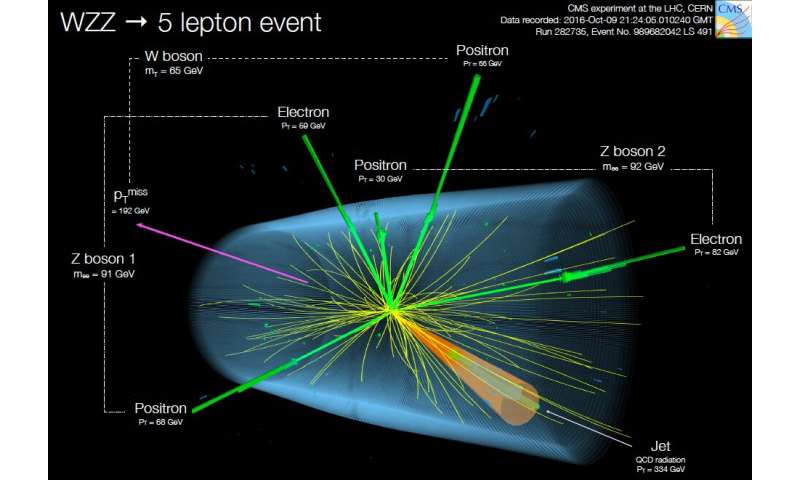
The Standard Model, the most exhaustive existing theory outlining fundamental particle interactions, predicts the existence of what are known as triboson interactions. These interactions are processes in which three-gauge bosons are simultaneously produced from one Large Hadron Collider event.
Triboson interactions are incredibly rare, often up to hundreds of times rarer than Higgs boson events, as they typically take place once every 100 billion proton-proton collisions. Although the Standard Model predicts their existence, physicists had so far been unable to observe them experimentally.
The CMS Collaboration, a large group of researchers from numerous physics institutes worldwide have recently observed the production of three massive gauge bosons in proton-proton collisions for the first time ever. Their paper, published in Physical Review Letters, offers the first experimental evidence of the existence of triboson interactions, opening up new possibilities for the study the interactions between fundamental massive gauge bosons, namely the W±, Z, and Higgs boson.
"The rarity and the novelty of triboson interactions was the main guiding force behind our decision to embark on a search for these events," Saptaparna Bhattacharya, post-doctoral research associate at Northwestern University and distinguished Researcher at the LHC Physics Center at Fermilab, told Phys.org. "Our achievement is a culmination of previous attempts to look for these processes by both the ATLAS and CMS collaborations at center of mass energies of 8 and 13 TeV."
The CMS experiment is an ongoing research effort based on the use of a general-purpose detector at the LHC (i.e., the Compact Muon Solenoid or CMS). Over the past few years, Bhattacharya and the rest of the CMS Collaboration used this detector to gather data related to particle interactions, which could aid the search for dark matter and facilitate the discovery of new physics.
In their recent study, the researchers examined a large dataset compiled using the detector between 2016 and 2018, as they realized that triboson interactions are becoming more accessible and have event rates large enough to be discerned from background signals. They thus set out to search for tribosons or VVV (i.e., where V=W+, W-, Z bosons) and establish the existence of triboson interactons at 5.7 standard deviations, which implies that the probability of the observation being a fluctuation of the background is one in 106, or one in 1 million.
"While the majority of triboson decay modes involve hadronic jets, a subset of events that give rise to electrons and muons (collectively known as leptons) lead to distinctive signatures in the detector," Bhattacharya explained. "The CMS detector is the best-known instrument for detecting leptons and we took advantage of this feature to isolate the rare VVV events from background processes."
The probability that large bosons will be produced in proton-proton collisions is greater at a center of mass energy of 13 TeV, compared to lower center-of-mass energies assessed in past studies. Using optimal signal selection requirements, the researchers were thus able to isolate the rare triboson process from backgrounds signals in the 2016-2018 CMS dataset.
"The presence of the W± and Z bosons produced in proton-proton collisions can be inferred by detecting their decay products," Philip Chang, post-doctoral researcher at University of California San Diego and part of the CMS Collaboration, told Phys.org. "One of the clearest signs of their presence is the detection of high-momentum electrons and muons. Since the process we wanted to detect involves three massive gauge bosons, multiple electrons and muons should be present as the event takes place, while in other background events that do not produce multiple massive-gauge bosons, the number of electrons and muons is low. We thus looked for proton-proton collision events with multiple electrons and muons to observe the very rare signal process from background events."
In the data they analyzed, Bhattacharya, Chang and the rest of the CMS Collaboration clearly identified the production of three massive gauge bosons in a proton-proton collision. Their findings are a significant contribution to the field of particle physics, as they introduce new possibilities for studying interactions between massive gauge bosons. In the future, this study could help to improve the current understanding of different types of large bosons, including the recently discovered Higgs boson.
"The observation of the production of three heavy gauge bosons in one LHC collision constitutes a major milestone in LHC physics," Bhattacharya explained. "At the outset, we were skeptical about discovering these processes at such an early stage of the LHC program. This discovery sheds light on the fundamental interaction between gauge bosons and opens a new window into the intricate details of the Standard Model."
The CMS Collaboration now plans to conduct further studies exploring the process they detected, as well as expanding their analysis to also search for events with W±, and Z boson decays to quarks and neutrinos. This will allow them to test the validity of the Standard Model further and potentially unveil new physical phenomena that cannot be explained by existing physics theories.
"We are currently studying triboson interactions in detail, having established their existence," Chang said. "One of the major goals of our next paper will be to scrutinize the newly discovered triboson processes and search for telltale signs of physics beyond what is predicted by the Standard Model."
Explore further
© 2020 Science X Network
Citation: Triple threat: The first observation of three massive gauge bosons produced in proton-proton collisions (2020, December 7) retrieved 7 December 2020 from https://ift.tt/2VN7XMf
This document is subject to copyright. Apart from any fair dealing for the purpose of private study or research, no part may be reproduced without the written permission. The content is provided for information purposes only.
"triple" - Google News
December 07, 2020 at 09:30PM
https://ift.tt/2VN7XMf
Triple threat: The first observation of three massive gauge bosons produced in proton-proton collisions - Phys.org
"triple" - Google News
https://ift.tt/3dc0blF
https://ift.tt/2WoIFUS
Bagikan Berita Ini
















0 Response to "Triple threat: The first observation of three massive gauge bosons produced in proton-proton collisions - Phys.org"
Post a Comment